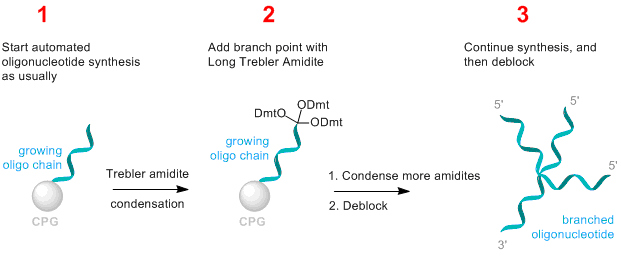Long trebler phosphoramidite
| Cat. # | Quantity | Price | Lead time | Buy this product |
|---|---|---|---|---|
|
24260
/ in 6 mL septum
|
250 mg |
$190
|
in stock | |
|
34260
/ in 6 mL septum
|
500 mg |
$290
|
in stock | |
|
44260
/ in 6 mL septum
|
1 g |
$490
|
in stock | |
|
54260
/ in 30 mL septum
|
5 g |
$1990
|
in stock | |
| 64260 | 10 g |
please inquire
|
in stock |

Long trebler phosphoramidite is a branching reagent for oligonucleotide synthesis allowing to synthesize branched DNA structures using a standard DNA synthesizer.

After the condensation of the trebler, three DNA branches begin to grow simultaneously with each step of the synthesis. Deblock of this construct gives rise to DNA containing a branching point. One arm (stem) is attached to the branch point with its 5'-end, and other arms (branches) are attached with their 3'-ends. Reverse amidites can be used to prepare constructs with different branch orientations. Repetitive condensations of trebler results in formation of DNA dendrimers.
Trebler amidite can be used to attach several modifier amidites to the 5'-end of an oligonucleotide - for example, three biotin residues can be attached at once.
This amidite does not require any special handling. Recommended coupling time is 5 minutes. No changes to deblock conditions are required.
Customers also purchased with this product
General properties
| Appearance: | viscous yellowish oil |
| Molecular weight: | 1475.78 |
| CAS number: | 1516489-83-0 |
| Molecular formula: | C89H107N2O15P |
| Solubility: | soluble in acetonitrile, dichloromethane |
| Quality control: | NMR 1H, 31P, HPLC-MS (95%) |
| Storage conditions: | Storage: 12 months after receival at -20°C. Transportation: at room temperature for up to 3 weeks. Desiccate. |
| MSDS: | Download |
| Product specifications |
Oligo synthesis details
| Diluent: | acetonitrile |
| Coupling conditions: | 15 min coupling time recommended |
| Cleavage conditions: | ammonia, 2 h at room temperature |
| Deprotection conditions: | identical to protected nucleobases |

























 $
$ 
